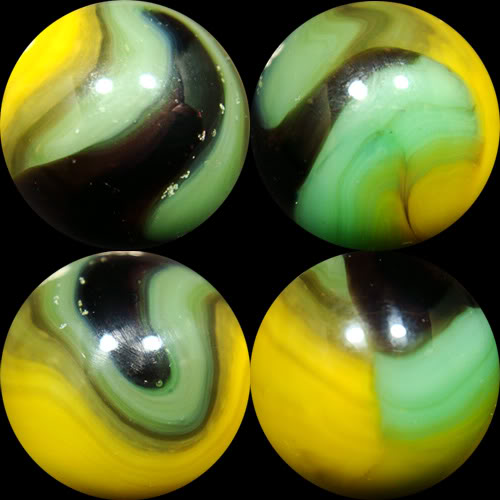Tags : :

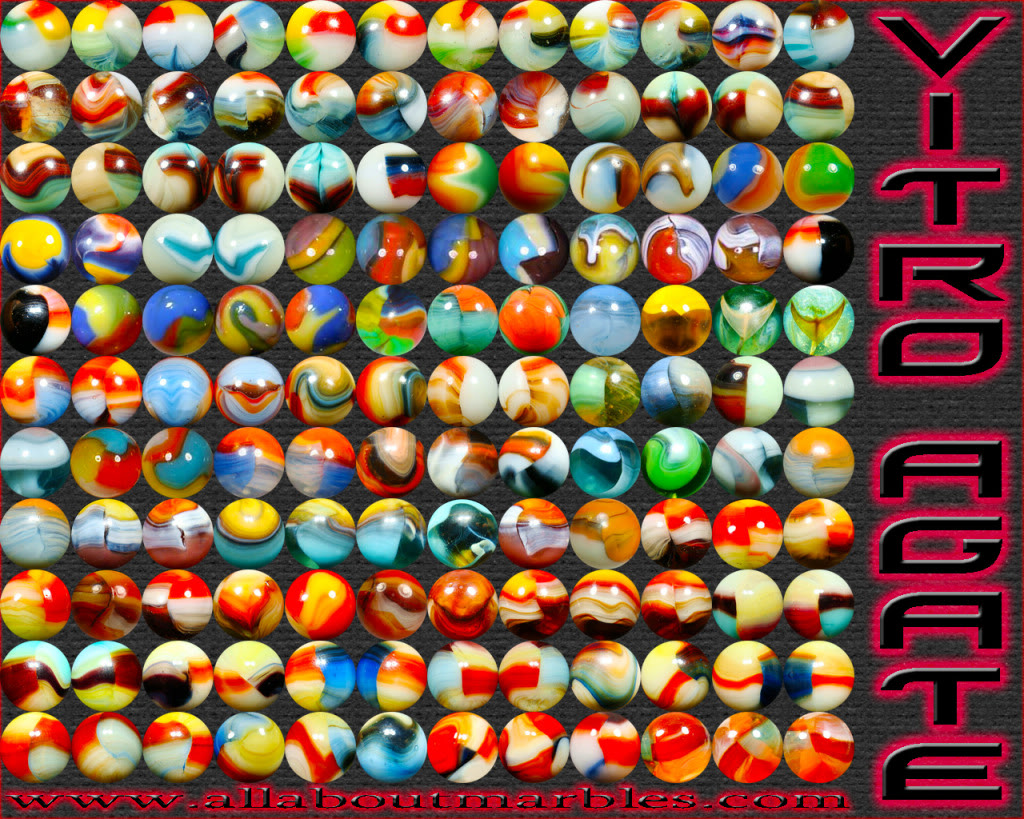
I fell in love with Vitro's when i first started collecting but didn't know it! What's not to love though right? I mean if you look at some of the early Vienna Vitro's and how clear and crisp the glass can be, they really are stunning to say the least. What about the Parkersburg Vitro's? The bright vivid colors! There are so many reasons to collect Vitro's it's insane but they can be really tough to figure out, especially for newbies. Even some long time collectors could learn a thing or two about Vitro's.
Anyways, i figured it was time i did another article on the forum here to help assist everyone with identifying Vitro Agates! First let me state that this may not be a 100% perfect article, different collectors see things differently. I am going to cover how i see things. I will be sharing a few names that only a couple people use. It's time they are known!VITRO TRI LITES / ELITES
First let me explain that there is NO difference between a Tri Lite and an Elite. They are both the same thing. Elite was a name given by a collector and Tri Lite was the name Vitro used. Among the Tri Lites there are sub categorized Vitro's. Such as the Aquamarines, Buttermilks, Aquamilks and Superiors. They are all Tri Lites but are sub categorized and were named by collectors..
A good way of identifying a Tri Lite is the crystal clear base glass. Some of the transparent based types will have a crystal clear base with a matrix (inside of the marble) that is blooming inside. Some times they will only be half full and the back side of the white will look ruffled and fluffy. Look for RED! A large number of your early Vitro's will have some kind of red in them, be it, red, burnt red or brown. That's where the term All Red came from. Vitro tried to have red in every marble!
Another tip is to look for some kind of transparency, almost all of your early Vitro's will have some kind of transparency somewhere on on the marble. The next thing to look for is the colors. A lot of your early Vitro's will have bright vivid bold colors and can sometimes be confused for Akro's. Most of your early Vitros, are NOT veneered.
Let's take a look at some early Vitro's! The picture below is a collage of the early Vitro Tri Lites.

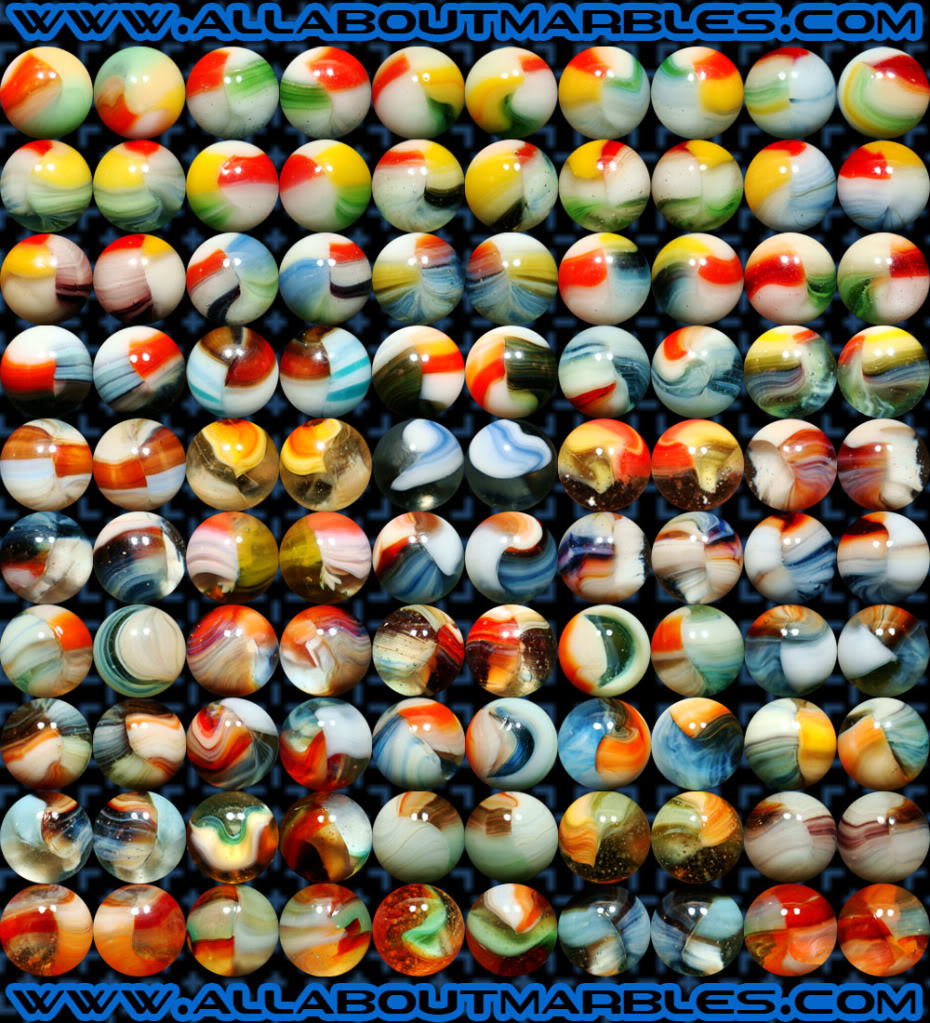
There are many more variations and color combos out there!
VITRO SUPERIORS
Now let's move on to the Sub Categorized Tri Lites. What about the Superiors? Superiors are still a Tri Lite, they are just a certain type. They have to have a red ribbon on both sides of the seams, surrounding a yellow patch on top. They can have Brown, Green, Sea Foam, Oxblood and Baby Blue patches on the bottom with white. Most of the time the bottom patch is made up of a blooming matrix of filaments. See examples below..

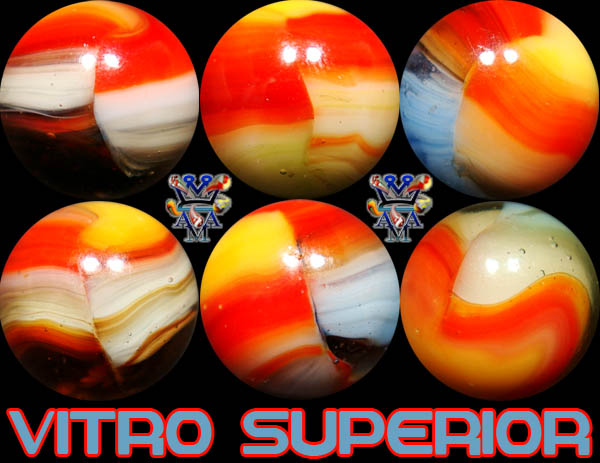

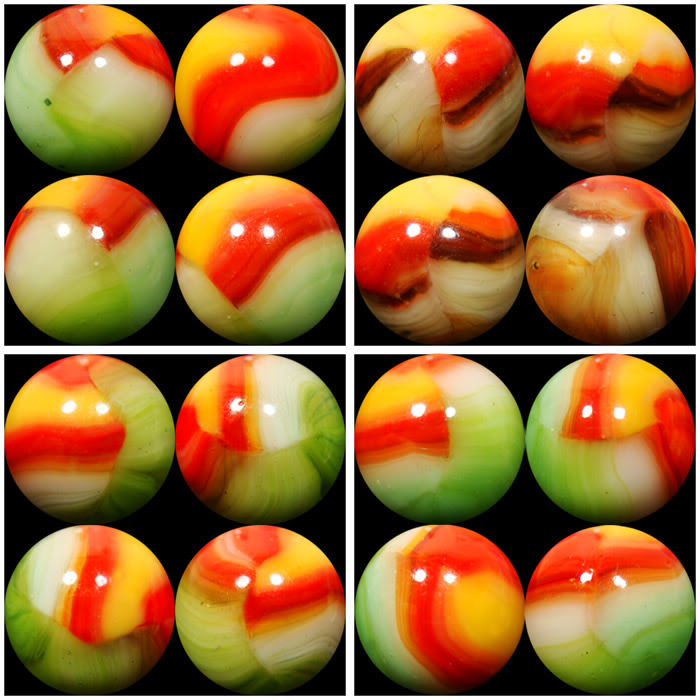

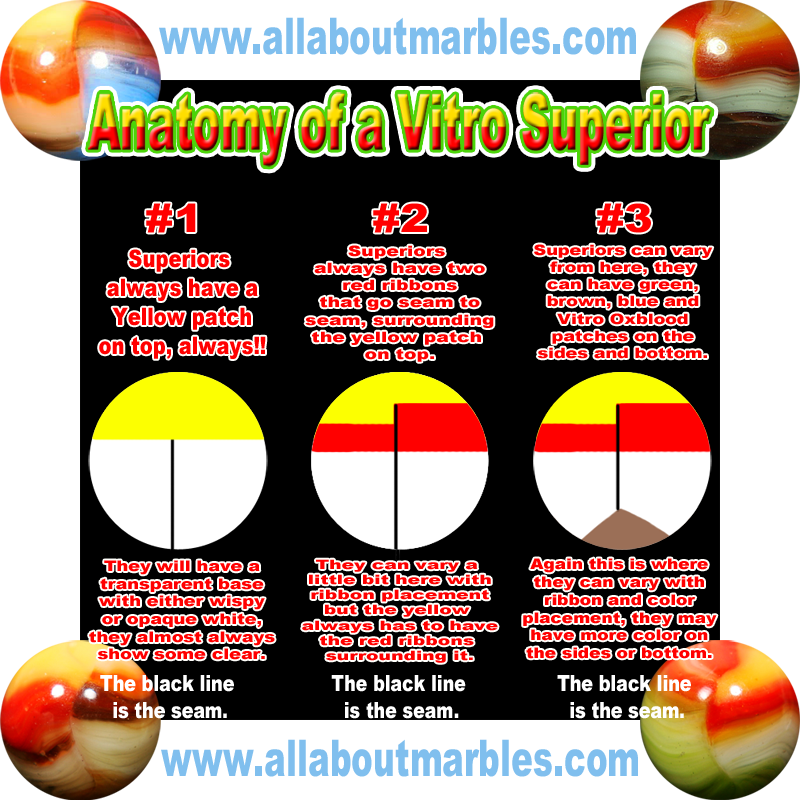
VITRO BUTTERMILKS & VARIATIONS
Another type of Tri Lite / Elite is a Buttermilk! One of my favorite types of Vitro's. There are a couple different variations of the Buttermilks but they all have one thing in common, the buttery yellow patch!
Most of the small Buttermilks are slightly oversize (larger than 5/8”) and the large ones usually range from 13/16” to about 7/8”. Buttermilks, unlike Superiors, vary a lot in design & color. This results in some difficulty in identification and likewise a lot of mis-identification.
The smaller 5/8 size almost always have your standard patch & ribbon configuration, the color bands can also vary as can the thickness or density which will determine the value . The buttery yellow is NOT opaque but rather a translucent yellow and can get heavy on some examples, these are the most sought after and most valuable. The thinner the colors the least appealing they are thus decreasing in value. Some folks call the weaker types Buttermilk Lites. A true Buttermilk is HTF but that does not mean the different Variations aren't just as pretty or valuable..
The larger Buttermilks will vary in coloring just like the smaller versions but the bigger ones can get VERY wild in pattern much like a Peltier Miller Swirl. The larger Buttermilks are VHTF...
Now comes the variations of Buttermilks, these can vary in colors and patterns, i liked the term Aquamilk for some and it is very fitting, i will be showing examples of different variations below. Some other types of variations have the buttery yellow but are NOT true Buttermilks but rather a variation and are thought to be made around the same time with the same method. Some of the variation types can be just as HTf as the standards but again they are NOT true Buttermilks.
Now enough of reading let's look at some pictures!!!
This is what Chuck B had to say about Buttermilks...
Buttermilks have a red band on one side, a parallel red/blue band on the other side and a translucent buttermilk yellow base, sometimes with white. Buttermilks vary considerably in color and design. The blue sometimes darkens towards indigo, especially on the shooters. The smaller buttermilks tend to have ribbons and many of the shooters swirl significantly.
That is what makes a Buttermilk a true Buttermilk, any type that doesn't fit that exact pattern is a variation which i will cover later on in this pictorial.
Standard 5/8 True Buttermilk.
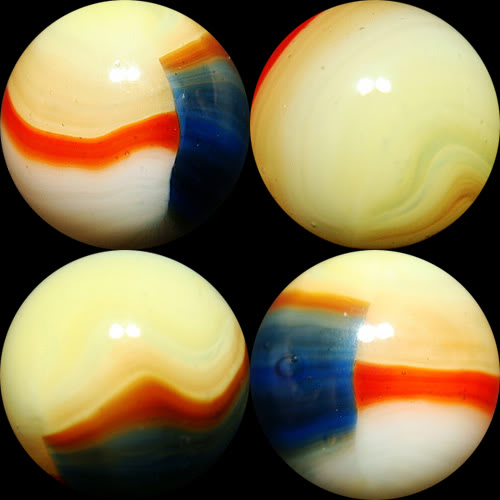
Standard 5/8 True Buttermilk. Notice how strong the Milk is on this mib.
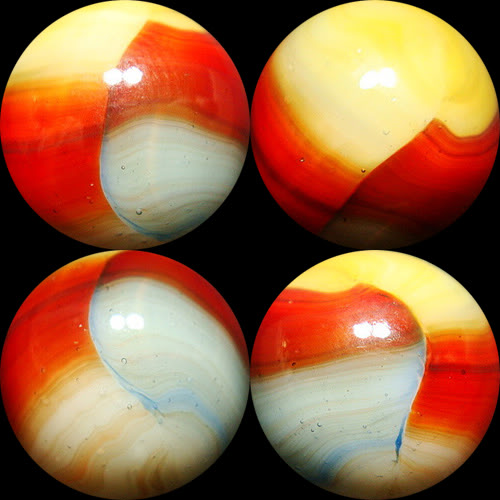
Standard 5/8 True Buttermilk.
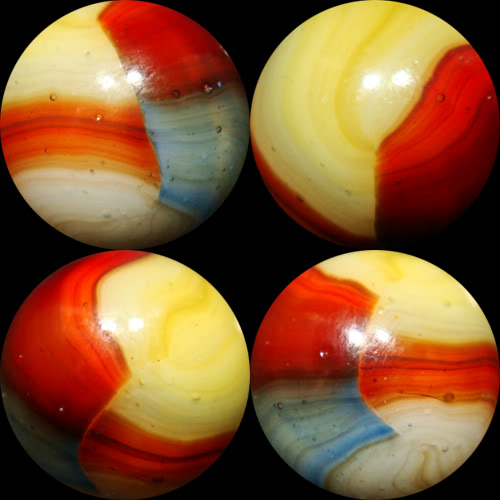
Standard 13/16 True Buttermilk Shooter.
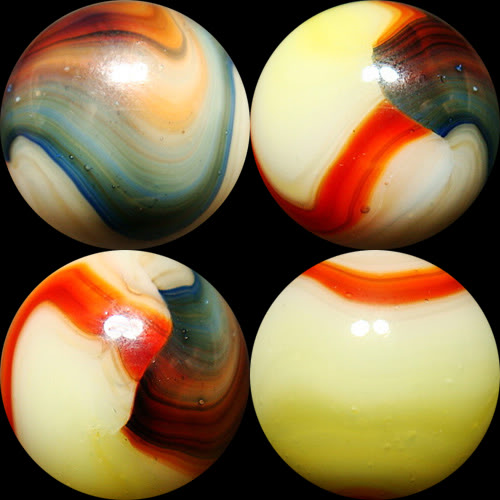
Standard True Buttermilk Shooter. Note the pattern is pretty wild.
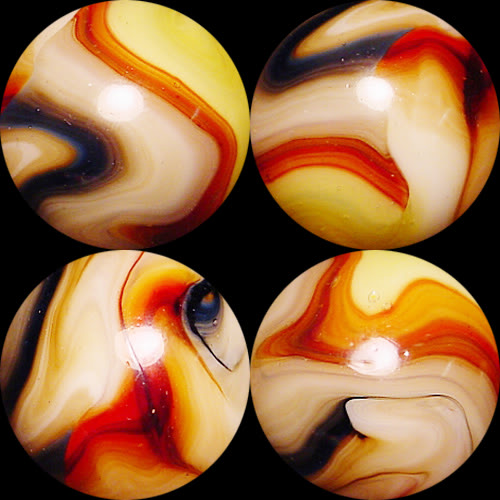
Vitro Aquamilk
Now that we have discussed and seen what a true Buttermilk is and looks like, lets move on to the different variations. I took one of these to the Canton Show last year and brought them to Chuck. B, i asked him if they was a Buttermilk type and told him i had been calling them Aqua Milks, he agreed and said they was a Buttermilk variant and that i was the first person he had ever seen call these types Aquamilks other than himself.
The Aquamilk will have that same Buttery Yellow patch just like the standard Buttermilk but with some different coloring on the ribbons, they can range in shades just like the Buttermilks from translucent to semi opaque. Not sure if these come in shooter size as I've never seen one before over 5/8. That does not mean that they aren't out there. They will exhibit an Aqua color much like the Aqua Marines but they lack the rest of what makes up a true Aqua Marine and they have that Buttery Yellow patch just like the Buttermilks so they are NOT Aqua Marines or Aqua Marine types. They will have a red to brown patch on one side with an opposing ribbon of either red, purple or brown.
5/8 Aquamilk. Note the similarities in pattern and the Aqua patch with the buttery yellow.
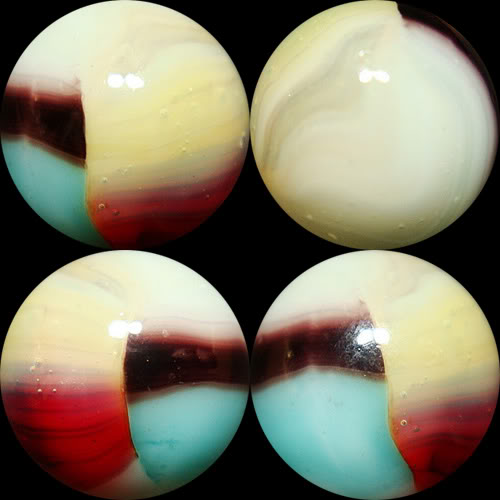
5/8 Aquamilk. Note the similarities in pattern and the Aqua patch with the buttery yellow.
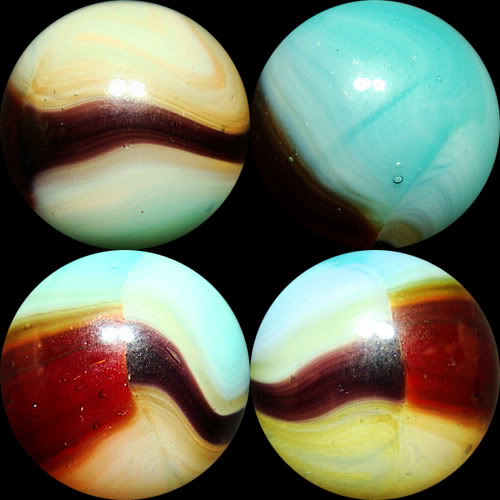
Now that we have covered the Aquamilks it's time to move on to the unnamed type of variations. There may be names for others but the two names I personally use are for the two different examples posted above. Below I will show some examples of a Weak-milk or Milk-Lite and another type or variant of the Buttermilks. They are both in the Buttermilk family, but again, the only types that are true Buttermilks are the standard examples I mentioned and photoed above.
First is a Weak-milk or Milk-lite. Notice how weak the buttery yellow is. These types are very nice but less valuable and less desirable than the regular Standard Buttermilks due to the lack of bold & strong coloring in the milk department. Also they are not a true Buttermilk due to pattern.
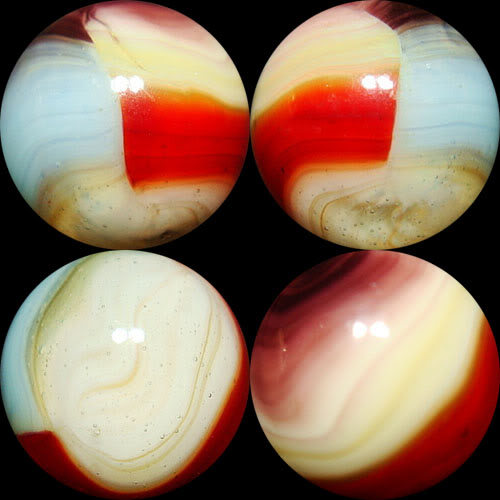
Second is a Buttermilk variation. Due the lack of the second opposing red ribbon being visible at the surface, some may still call this a true Buttermilk, but it is mine so for now I will say this is a variant due to the red ribbon not showing on the surface. Still has a nice amount of bold buttery yellow but is not a true Buttermilk in my opinion...so again these types are less valuable but still a very pretty Vitro Buttermilk Variation and will demand a premium price, if it were a true Buttermilk it would demand an even higher premium price$$$$...
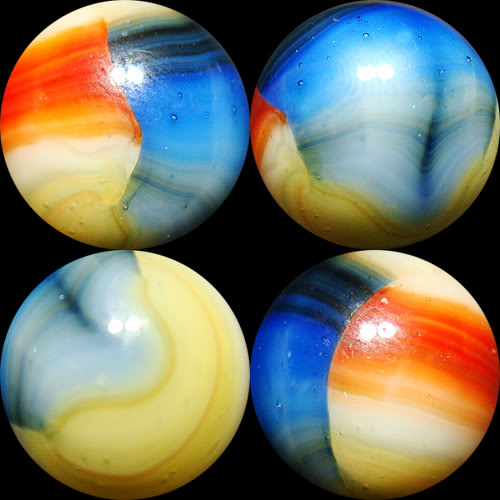
Third is another type of variation. Of course it lacks all the main things to be a real Buttermilk but it still has that buttery yellow. These types won't bring the $$ like a typical standard will bring but never the less they are in the Buttermilk family making it a variant.
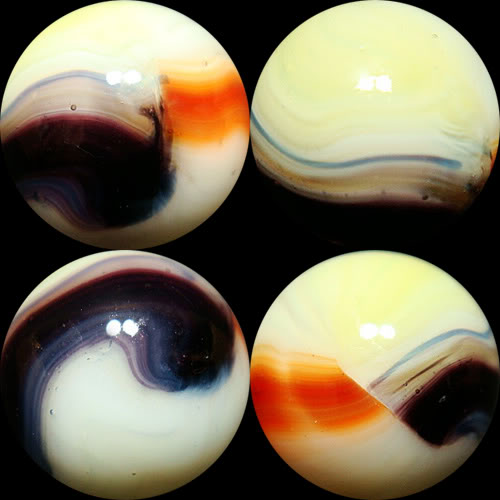
VITRO AQUAMARINE
The Vitro Aquamarine is a Vitro Tri Lite / Elite, it's just a sub categorized tri lite just like the Buttermilks. The Vitro Aquamarine is a stunning marble. They was named Aquamarines due to the colors.
You can usually spot an Aquamarine once you have seen a couple. They are not to rare but can be HTF is different regions. They can vary in shade, intensity and coverage.
They will always have the Aqua color on a tan or sometimes grayish looking base. They also always have some type of ribbon that is either red, brown or sometimes even oxblood (which are the rarer types).
See examples below.

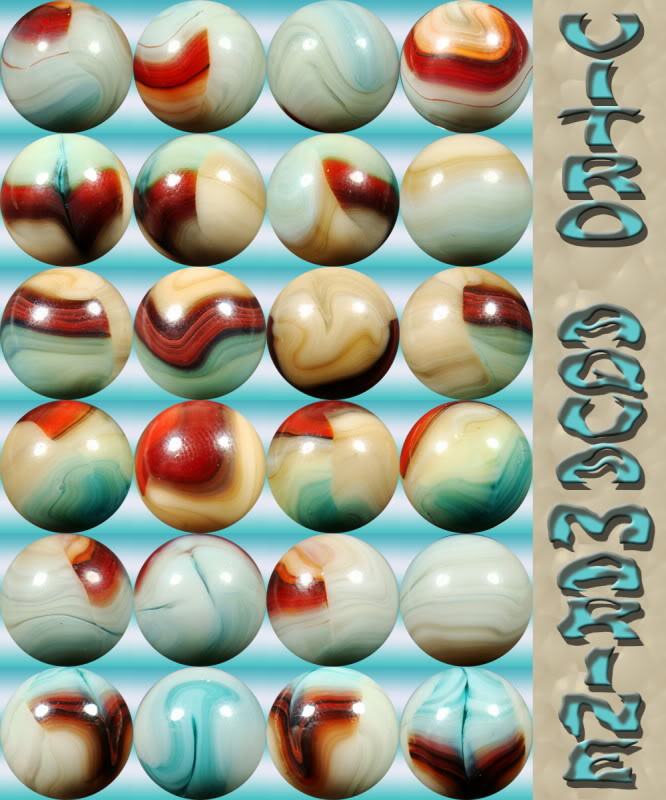
VITRO HELMET
The Vitro Helmet is yet another Vitro Tri Lite / Elite, it's just a sub categorized tri lite. The Vitro Helmet is one of the well known Vitro's.
The Vitro Helmet was named because when they are viewed at a certain angle, they look like a helmet.
Vitro Helmets come in an array of colors. They can have a transparent patch or an opaque patch. The rarer colored patches include, red, opaque black and purple.
Vitro Helmet's also come in an array of sizes.
See examples below.


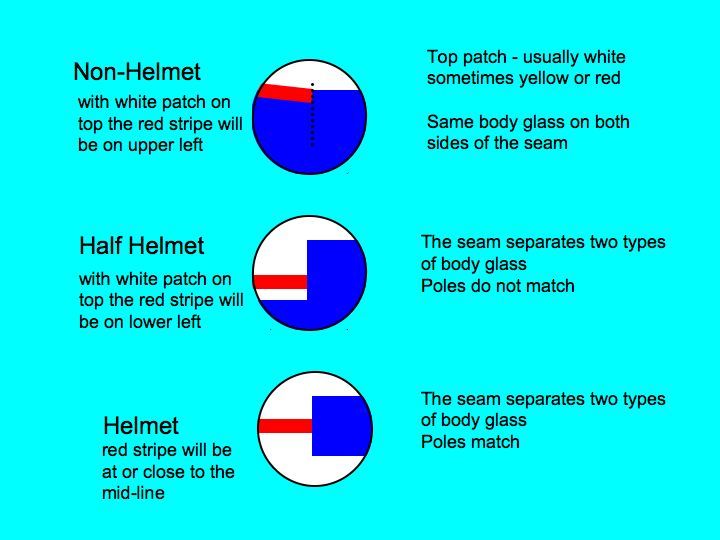
VITRO VICTORY'S
What exactly is a Victory? Most collectors learn what a Victory is very early in their marble collecting adventures. The Victory's tend to show up less than the Conquerors and are harder to find than one might think.
Let's cover the Victory's as they are pretty straight forward. Victory's have a clear, colorless transparent base with a colored patch on top. Simple enough.. See examples below.


VITRO CONQUERORS
Can you conquer the different types of Conquerors?? Again. most collectors learn what a Conqueror is very early in their marble collecting adventures as they seem to show up in numbers in lots or jars.
So what is a Conqueror and what do i look for? Well there are 4 different types of Conquerors. There is a Regular Conqueror, Phantom Conqueror, Fancy Conqueror, Exotic Conquerors and of course Hybrids. Fancy's and Exotics are fairly new to the scene and the terms have only been used by a very limited number of collectors.
Lets break down the different types of Conquerors.
First up is the standard Conqueror. Color patch on top, clear transparent base with white covering the the rest of the marble. See examples below.
Note: the patterns can get swirly on these some times.

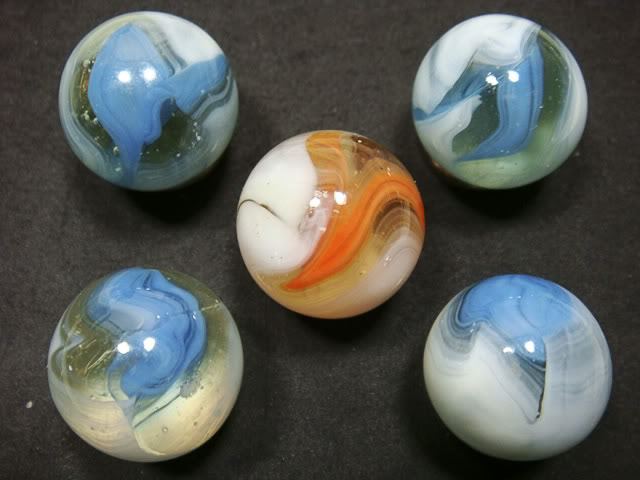

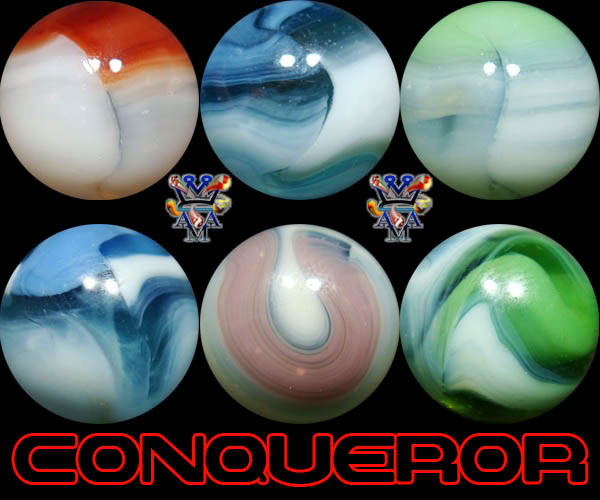
Next is the Phantom Conquerors, they have the same trait as a regular Conqueror with a colored patch on top but they differ in how the white looks. Instead of looking veneered or brushed, they have a blooming matrix of white filaments.
See examples below.

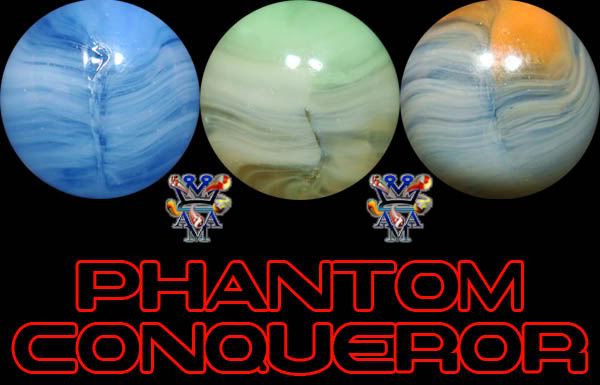
With me so far? Good! Now we move on to the Fancy Conquerors! It is believed that some of the Fancy's or Brushed Patch types are earlier types of Conquerors, i also agree with that theory. Fancy Conquerors can consist of several different traits. They can vary a lot but they usually stand out among regular Conquerors. They can have two or more colors or a colored transparent base (usually Amber) and can sometimes look opaque. See examples below..


Next up is Exotic Conquerors. These are some of my favorite Vitro's.
Note: These are also on a transparent base and will exhibit very vibrant colors, some times they will have two different colors on each pole and will show an icing like brushed look around the equator. You will know these when you see them as they are very different than the other Conqueror's posted above. Some of the examples posted below may not be Exotics to some people but IMHO they are far nicer than a Fancy, so for now i will keep them with my Exotics. The better examples show a nice open window to the matrix of the marble.
Don't get these confused for Fancy Tiger Eyes because their not. They precede Tiger Eyes by almost a decade.

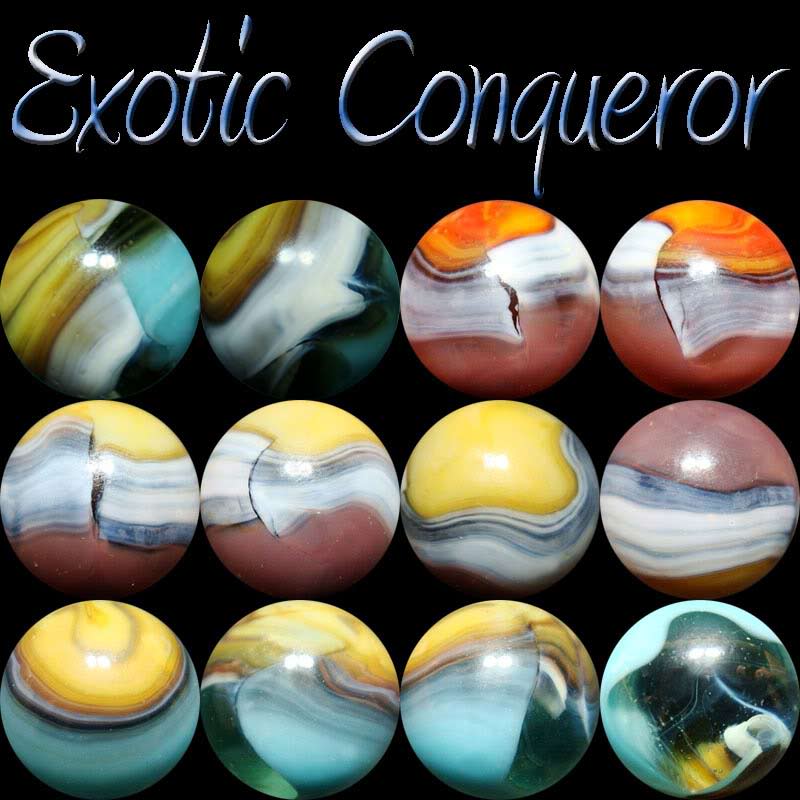

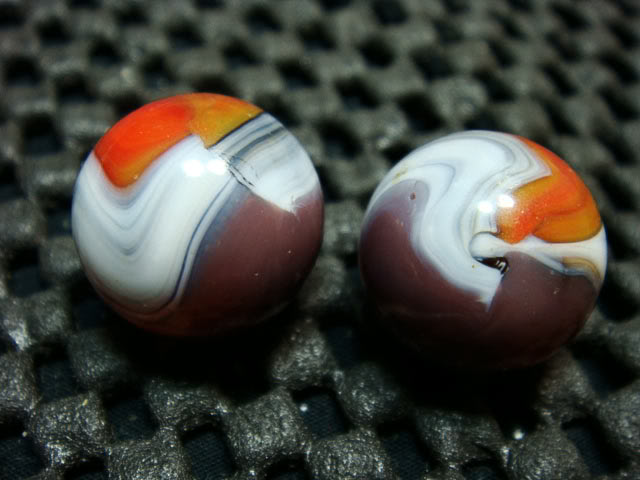
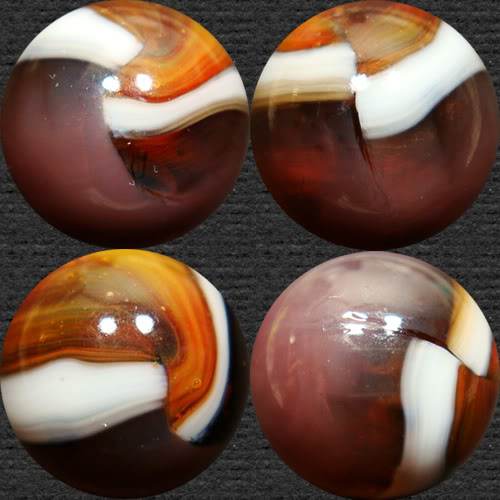
This collection belongs to Chuck and Dianne B.

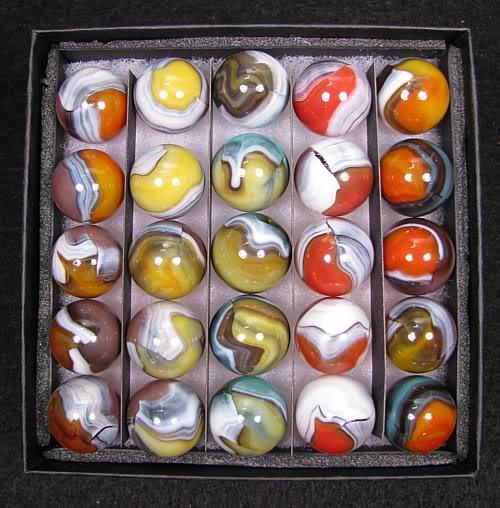
Multi Colored Neon Conquerors
Last but not least on the conqueror list are the types below. The Neon Conquerors are rarer than any other Conqueror and are by far the best looking ones. They usually have 4+ colors that look neon and come in shooter sizes (I've yet to see or find one smaller than 13/16). Mine are 13/16 and 15/16. They are also a veneered marble on a transparent base.
See examples below.
Vitro Neon Conqueror

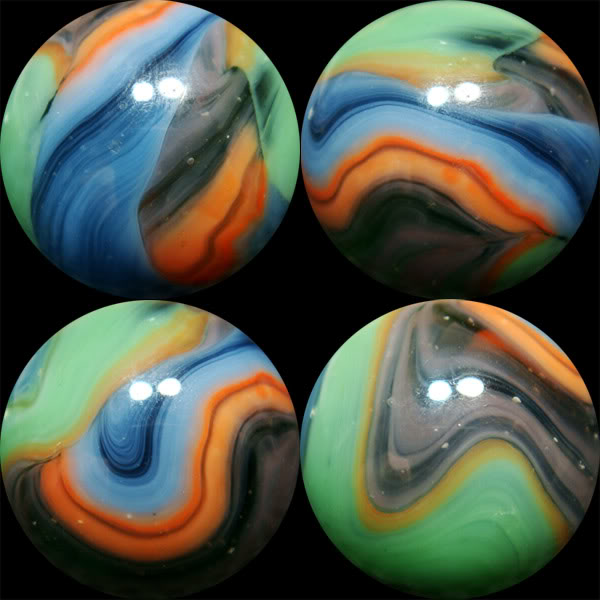
Vitro Neon Conqueror

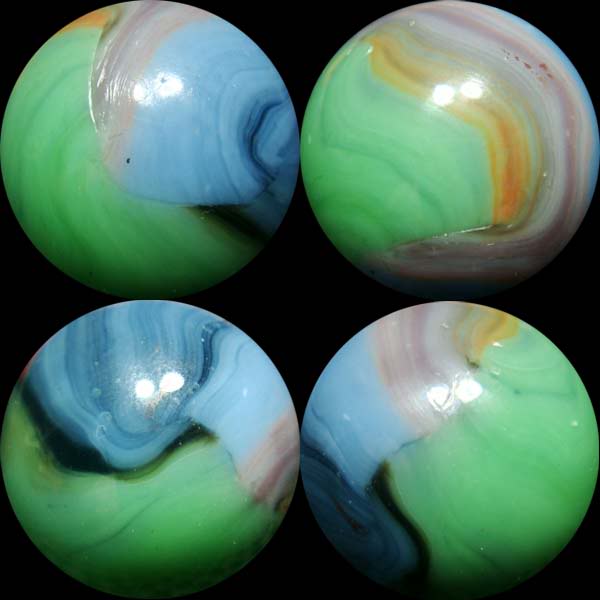
VITRO BLUE DEVIL
Another favorite of mine is the Vitro Blue Devil. I believe these to be in the Conqueror family, early ones. The base is a striking cobalt blue, white ribbons and a pink or lavender patch on top. I have these in two different sizes but most of the time they are shooters. One of the better Conquerors i know of.
See examples below.
Vitro Blue Devil

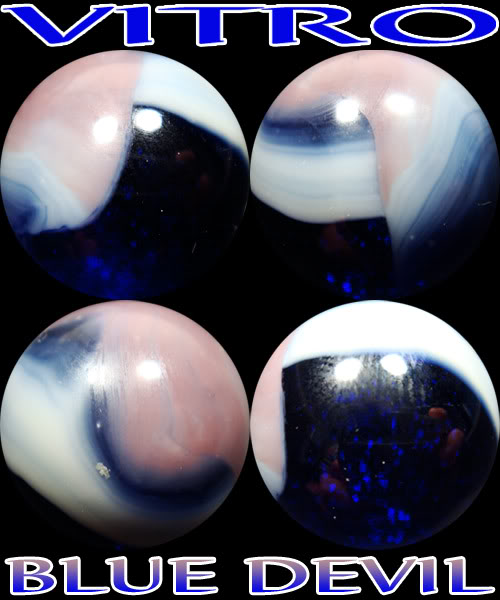

Vitro Blue Devil
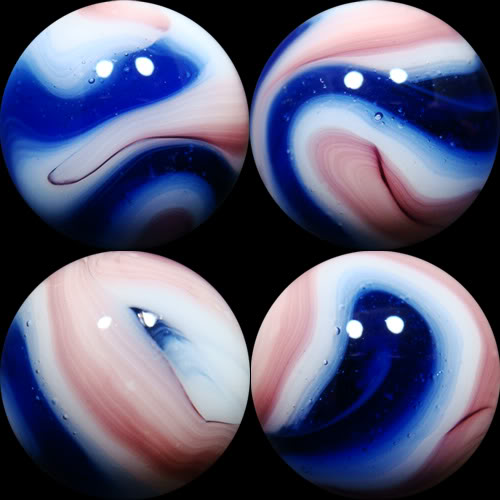
VITRO BULLS EYE
The Vitro Bulls Eye is similar to the Vitro Conqeuror but they have a colored (usually red) ribbon that goes from seam to seam surrounding the patch on top. They are also on a transparent base.
Vitro Bulls Eye

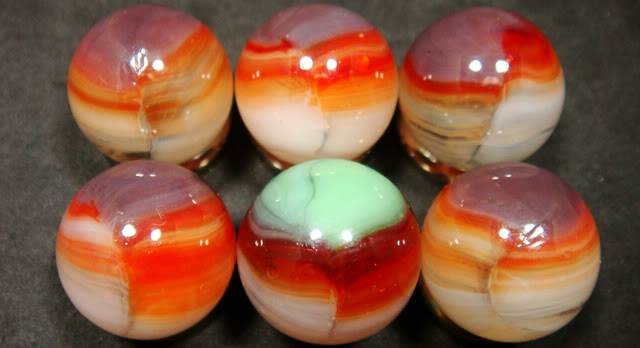
Vitro Bulls Eye
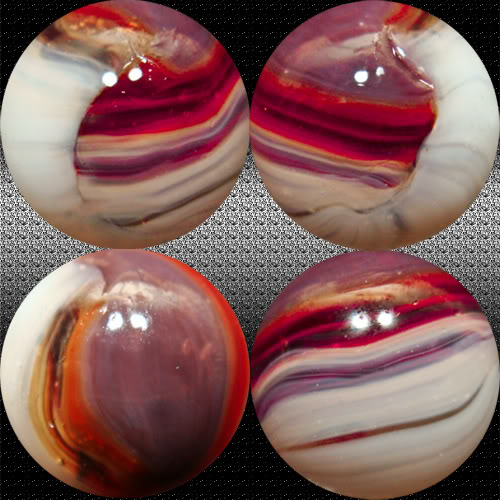

BACKLIT PIC OF A VITRO BULL'S EYE
VITRO ALL RED
I can just about guarantee that you have some All Reds in your collection, they are one of the most common Vitro's made. The term All Red stems from the owner of Vitro wanting to see red in every marble. They typically have an opaque white base with a veneered patch on top and a veneered patch on bottom with white showing around the equator ( this can vary, use your best judgement), one patch is always red. There are Hybrid All Reds to so look close. They range in size from the smaller 5/8 version up to the larger 15/16.
Sometimes you will hear the term Pepsi Marble used. If you look at the Red and Blue ones, you can see they slightly resemble the Pepsi Logo. They can have green & red, blue & red, brown & red and so on..
See examples below.
Vitro All Red

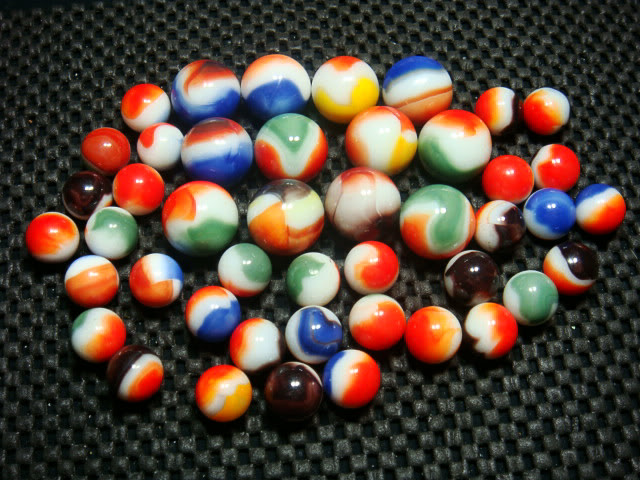
Vitro All Red


Vitro Hybrid All Red
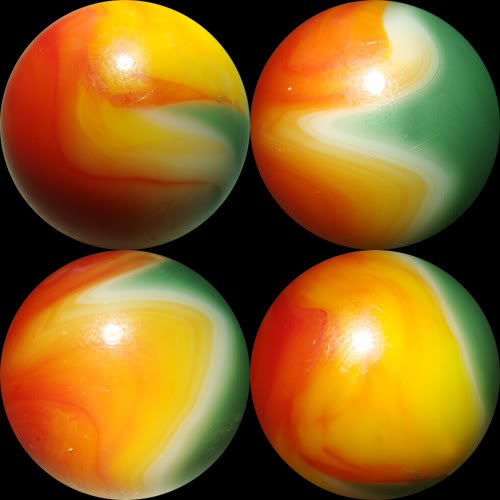
VITRO BLACK-LINE ALL RED
The Black-Line All Reds are very similar to the regular All Red in that they have a patch on one pole and a patch on the other pole. They also have to have a red patch on one of the poles. The only difference is the Black-Lines have a brown or purple (which is what we call black) ribbon going around the equator from seam to seam. They to vary in size from the smaller 5/8 up to the larger shooters.
Note: There is no such thing as Black on a Vitro marble, when we say black we mean brown or purple.
See examples below.
Black Line All Red

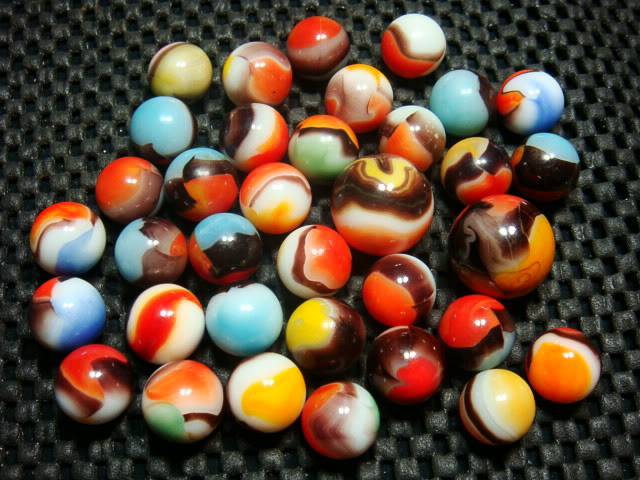
Black Line All Red

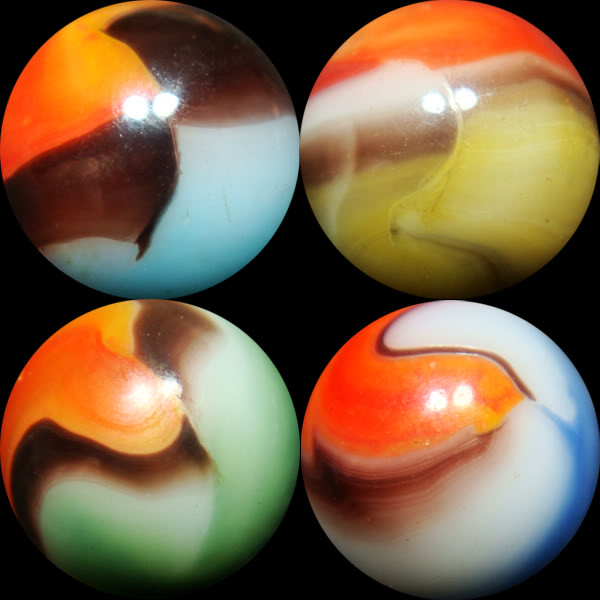
VITRO BLACKIE
Moving on to the Vitro Blackie i would like to first point out that even though they appear to be opaque, more often than not if you backlight one, you will find they are transparent or translucent and veneered. Now that we have stepped out of the All Red realm, we have to stop thinking that every marble has to have a red patch. Blackies may look similar in pattern but the construction of the Blackie is different. Blackies have the same color patch on both poles with that same black ribbon going from seam to seam around the equator.
See examples below.
Vitro Blackie


Vitro Blackie

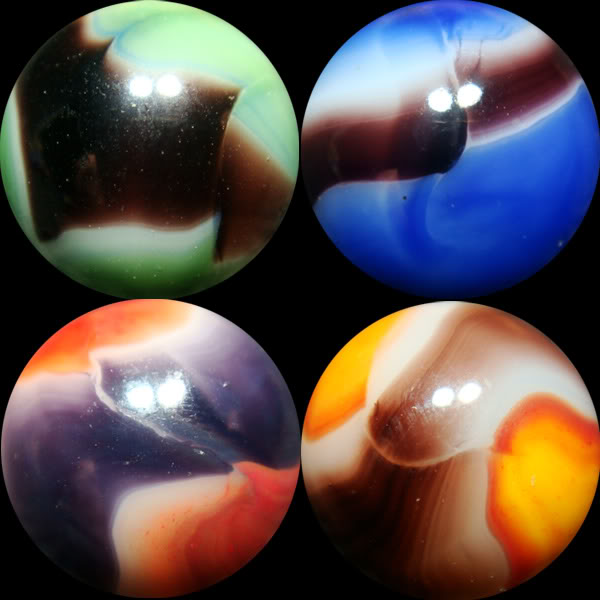
VITRO WHITIE
The Vitro Whitie is one marble that one would think is common. I can tell you now they are not as common as you think. The Vitro Whitie has no color on either pole a white base and a colored ribbon going from seam to seam around the equator of the marble. Vitro Whities can have AV in the colored ribbon and there are Hybrids.
See examples below.
Vitro Whitie


VITRO TIGER EYES
The Vitro Tiger Eye can be one of the trickiest to ID. They are not that bad once you sit down and figure them out.
CONSTRUCTION OF VITRO TIGER EYES – The basic construction is a marble with thin veneered patches on the top & bottom and a thin veneered half & half ribbon in the middle.
*Type 1…A clear base glass with a color patch on top, a white patch on the bottom and a two color (half & half) ribbon in the middle
*Type 2…A clear base glass with a color patch on top, a different color patch on the bottom and a one color (half & half) ribbon in the middle
*Type 3…A clear base glass with a color patch on top, a different color patch on the bottom and a white (half & half) ribbon in the middle
Type 4…An opaque white base glass with a color patch on top, a different color patch on the bottom and a white (half & half) ribbon in the middle.
I put together a pictorial together below to show you with a visual instead of words, i think it will help you guys learn them quicker.
So i made a pictorial for everyone to see what makes up the different types of Vitro Tiger Eyes.
Remember that the colors can vary in shades and different colors completely! But one thing never changes, the pattern and construction! I would also like to add that the Type 2's can have two different colored ribbons in the middle.

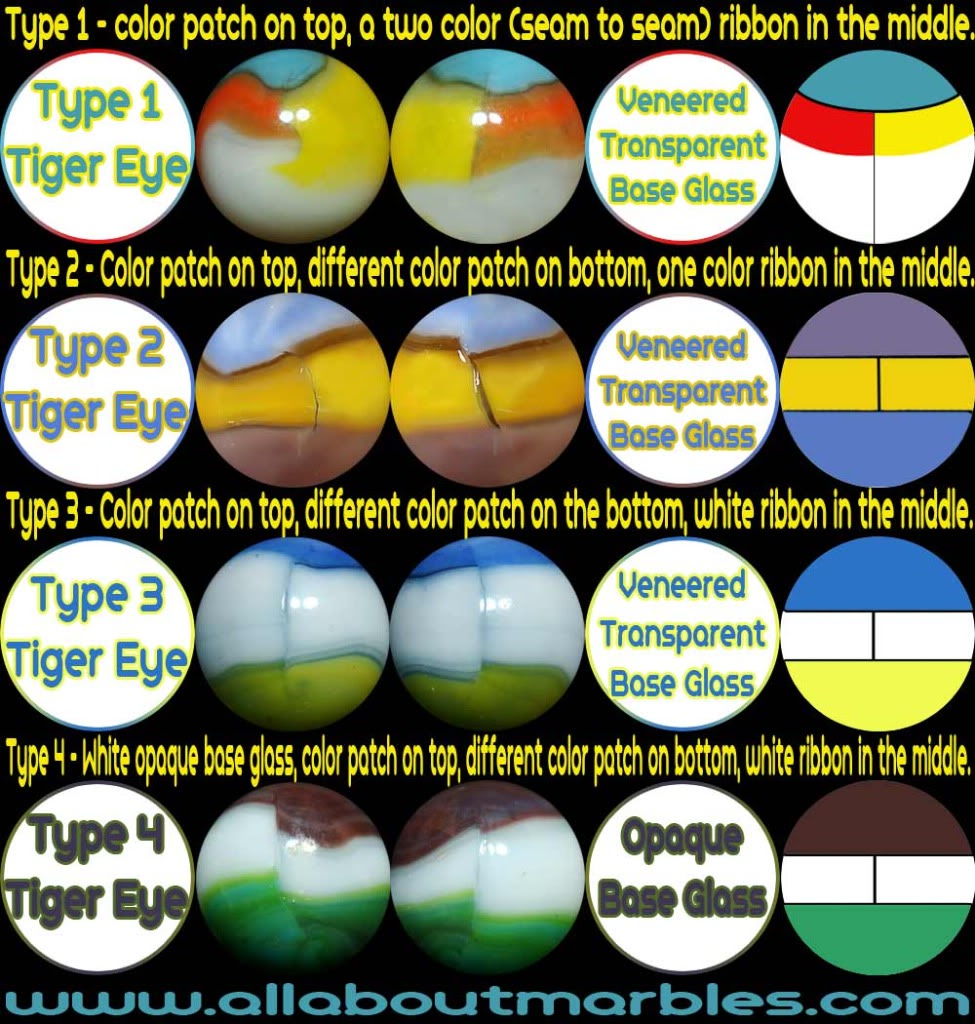
Type 1 with Oxblood

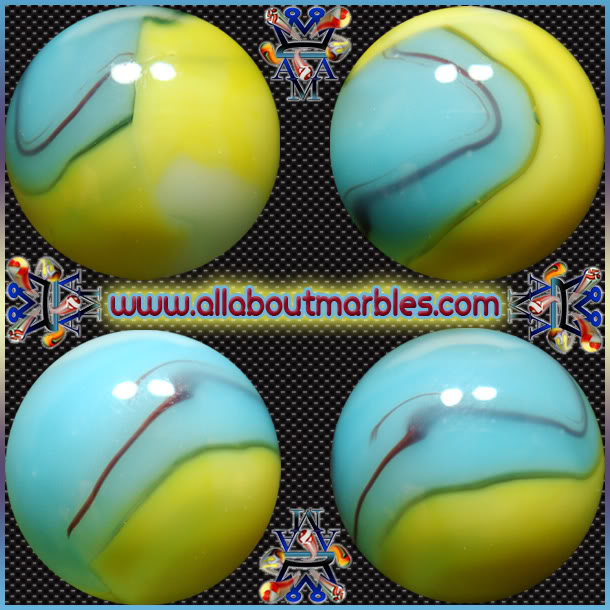
Full Coverage Type 1

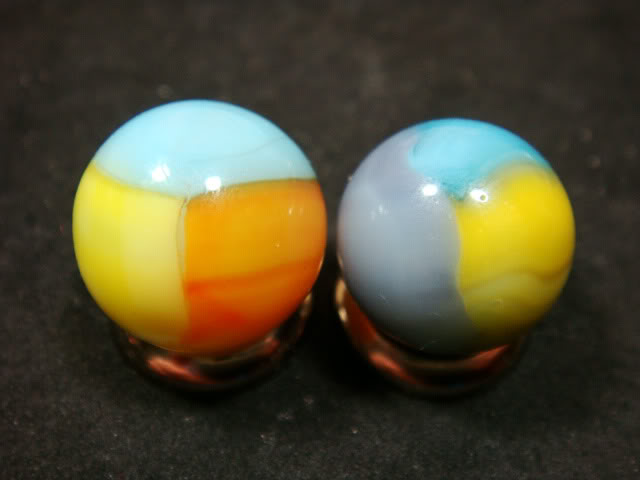

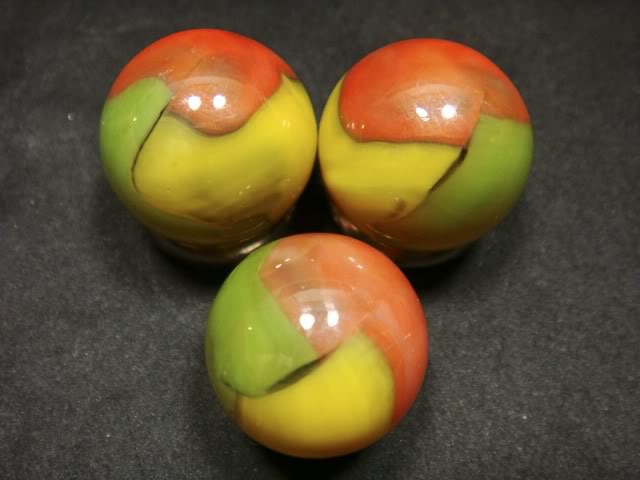
Type 1 Tiger Eyes.

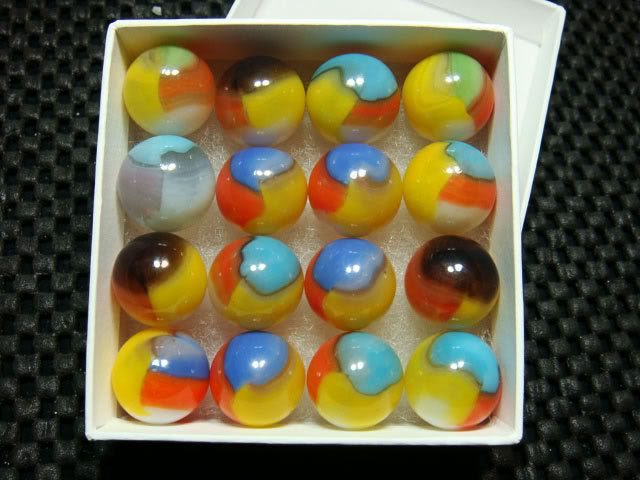
Type 2 Tiger Eyes.
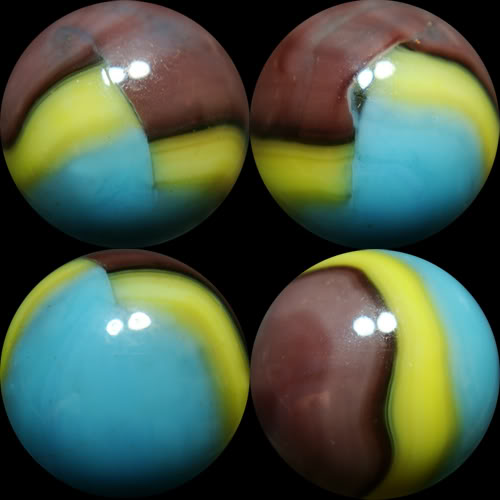
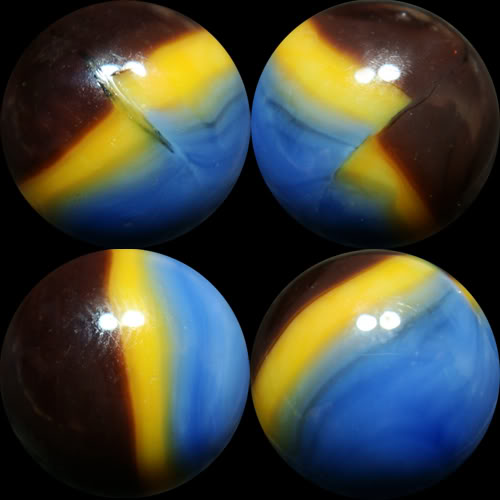
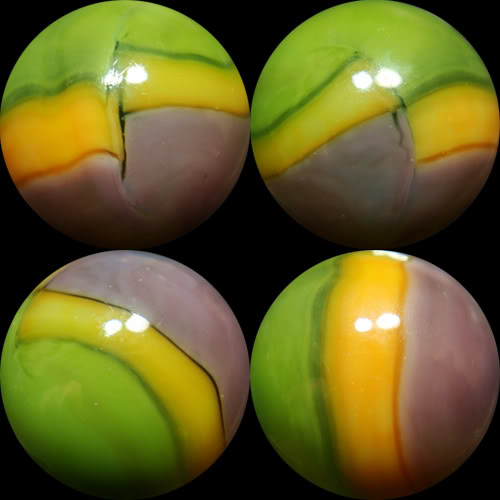
Hard to find Type 2

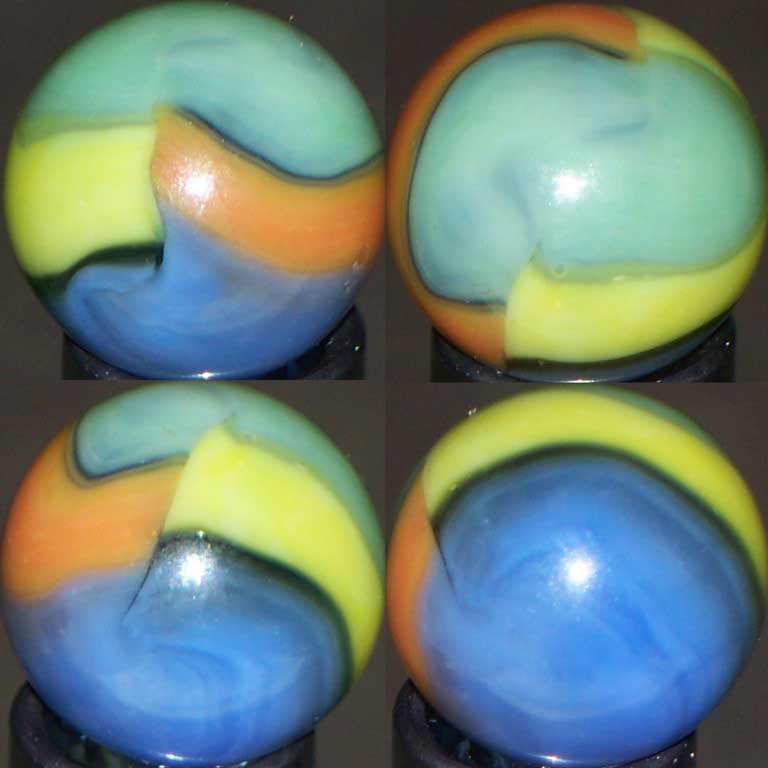
Type 3 & 4 Tiger Eyes

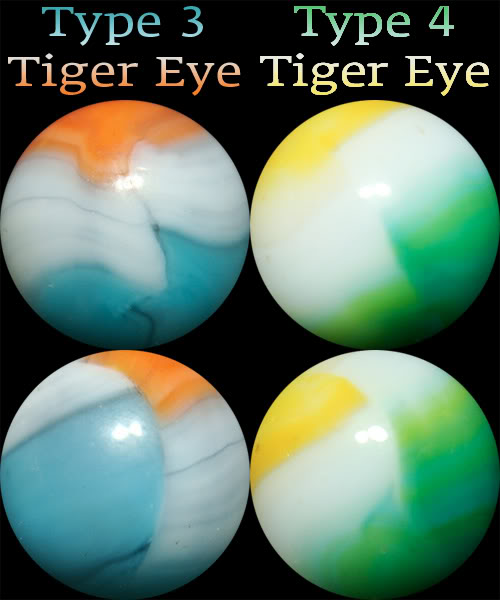
Random Tiger Eyes.

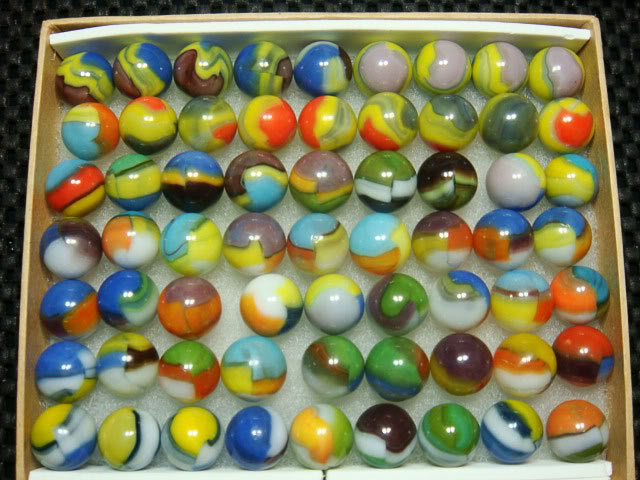
VITRO WEDDING CAKE
The Vitro Wedding Cake is one marble that is rare. There are variations of a Wedding Cake but the true types are vhtf and the red ones are rare. Real Wedding Cakes have an off white base, with a colored patch on top and a bright white (icing like) border surrounding the colored patch. The rare ones will have a red patch.
Now in my opinion, real Wedding Cakes have to have the off white base, not grey and are shooters meaning 3/4+. I believe they are one of the relatively few opaque based patches made while Vitro was in Vieena. A good way of testing to see if it's a Wedding Cake is to see if it glows. So check em out and good luck on your Wedding Cake hunt!
Vitro Wedding Cake
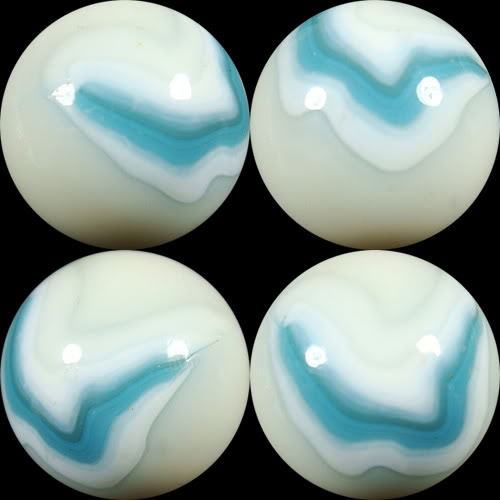
Looking for more pics of these if anyone has any to share.
VITRO YELLOW JACKET
Ahh yes the tricky Yellow Jacket. I say tricky becuase there is still some confusion surrounding all the different Yellow Jackets. It was once thought that Vitro Yellow Jackets with a purple around the eqautor were not true Yellow Jackets. I may get some flac for this but it's time collectors start accepting that the prettiest Yellow Jacket of all is the one with the purple eqautor.
Vitro Yellow Jackets are kind of like a Black Line All Red but #1 the glass and colors are a bit bolder. #2 They always have a red patch on one pole and a yellow patch on the other pole with either a light blue, green, dark blue or purple ribbon going from seam to seam around the eqautor.
Now i'm still not sure how i feel about the brown ribbon but it does show in the Yellow Jacket Ad..
The Vitro Yellow Jacket can vary in size from around 5/8 up to the larger shooter size.
Vitro Yellow Jacket

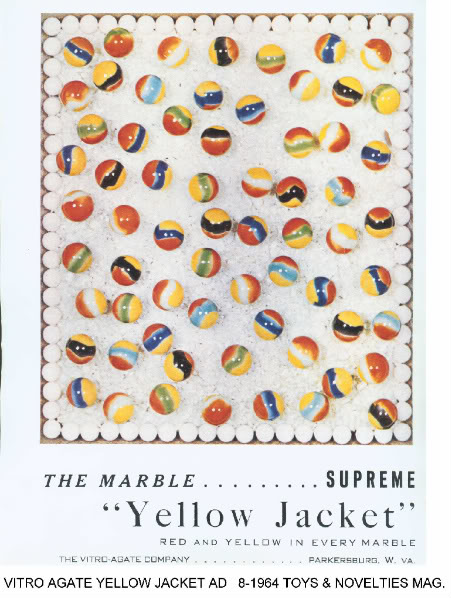
Vitro Yellow Jacket

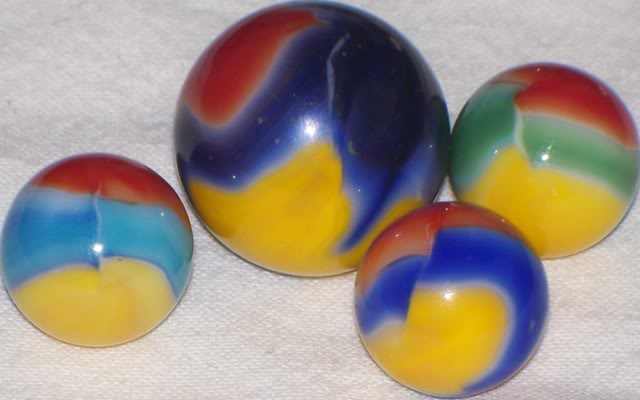
Vitro Yellow Jacket
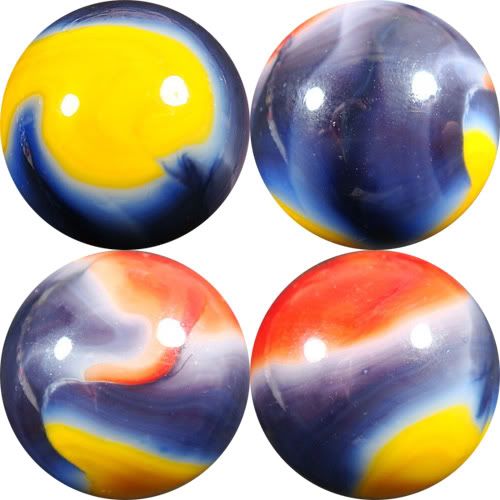
Vitro Yellow Jacket
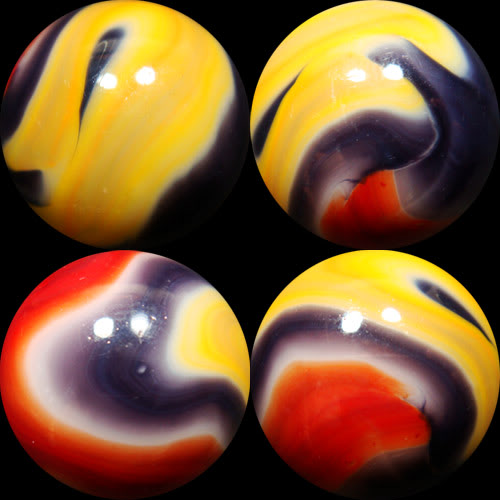
VITRO OPALS
Vitro Opals will usually light up an orange color when backlit, that's how they got their name. But i would like to add that not all Opals fire up orange. There are some that just don't fire, they still have the same colors and pattern and are still Opals but they lack the fire quality.
Vitro Opals have a transparent base and are veneered. The biggest ive seen to date is the smaller 5/8's types, there may be bigger so keep an eye out. There are Opals with Oxblood, they are the nicest ones in my opinion. Some have premium glass and demand a premum price.
Vitro Opal w/Oxblood
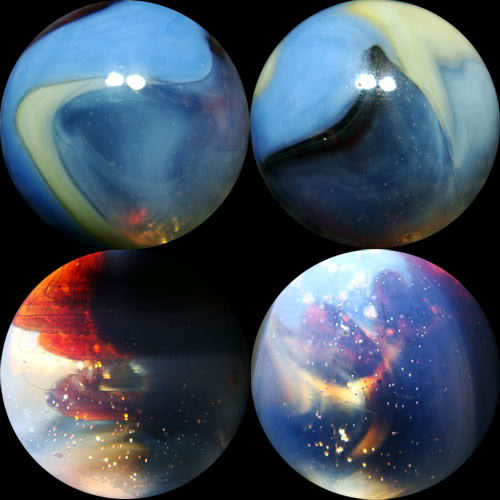
Vitro Opal

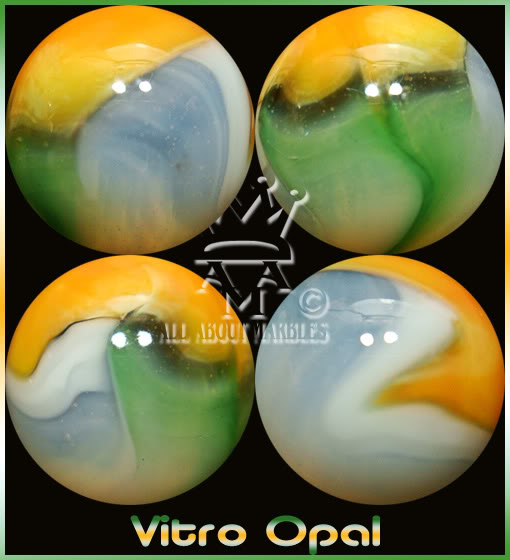

VITRO EASTER EGGS
The Vitro Easter Egg is one of the coolest Vitro's made. They will usually have a translucent base made up of a blooming matrix of wispy filaments. Most of the time, the matrix is powder blue. The colors are always pastel, much like an easter egg.
The Vitro Easter Eggs ive seen or have are all smaller, around 5/8's.
Vitro Easter Egg

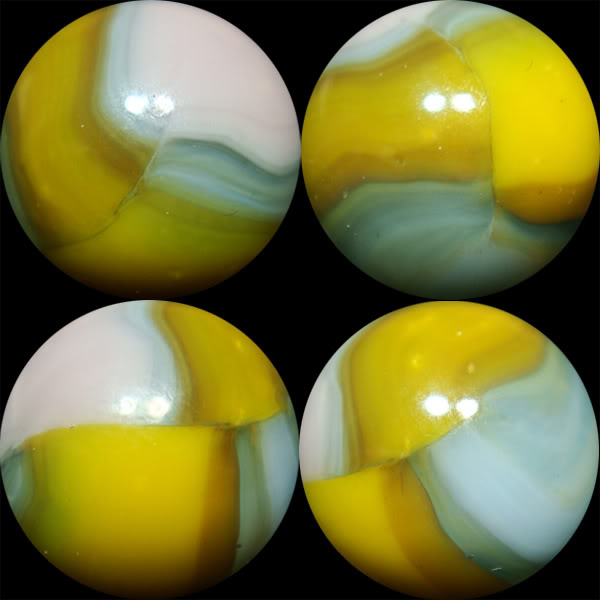
Vitro Easter Egg

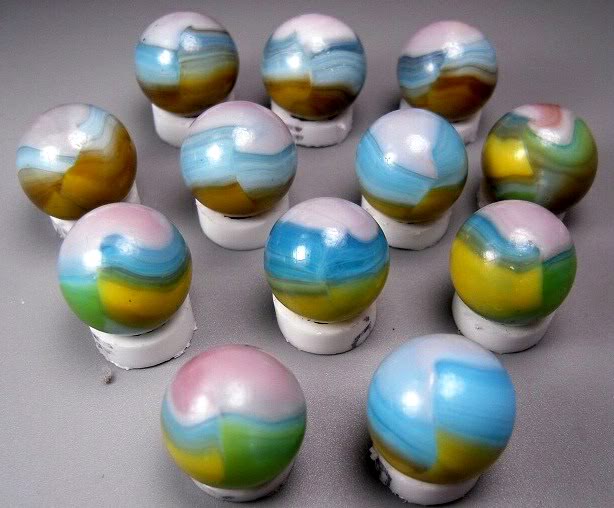
VITRO PARROT
The infamous Vitro Parrot is one of the well known Vitro's. They can range in size from around 5/8's to the larger shooter sizes. There is a myth that smaller Parrots are called Parakeets, sorry, but this is not true. They are just small Parrots.
According to past Vitro plant manager Blaine Lemon. The goal for a Parrot was opaque white base with four colors not including white,size was 7/8. The better ones will show no white. They also made smaller size ones. Parrots were Blaines favorite marble. He always had them in his pockets,every time that i was around him,no matter where.
Vitro Parrots must have 4 or more colors and have little to no white showing. There is an allowence to the amount of white but let me warn, it better be very little or most collectors (including myself) will not call it a Parrot. They always have an opaque base and can sometimes have Aventurine.
The larger Parrots can sometimes get a bit swirly. They are a veneered marble with an opauqe base.
Smaller 5/8's Parrots.

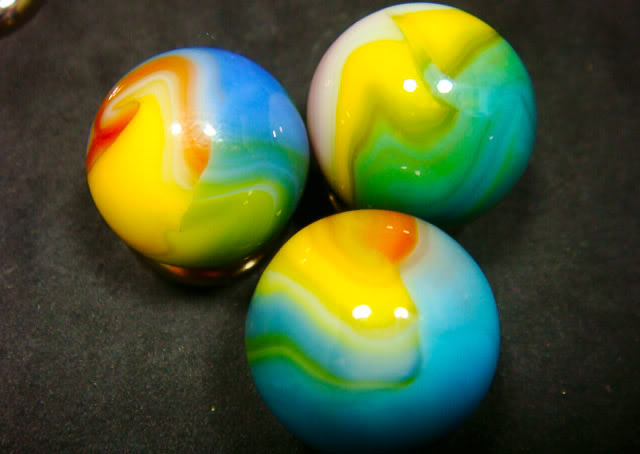
Larger Parrots


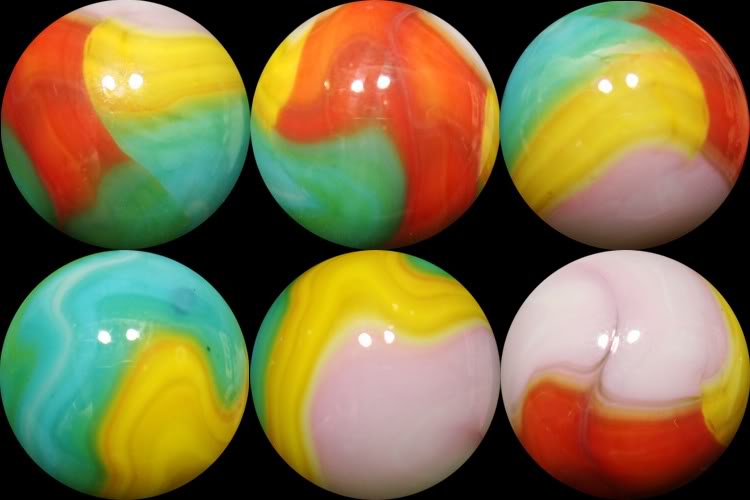

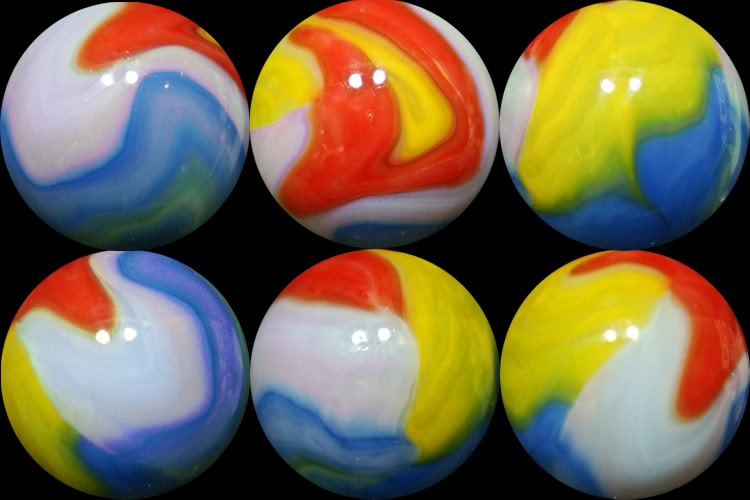
VITRO SWEET PEA
Ahh yes, the good old Vitro Sweet Pea. Sweet Peas have a green base, with a yellow ribbon and a pink patch that can vary in color. The better examples have the pink patch. They can also range in size from the smaller 5/8s up to around 3/4, i don't think ive seen one bigger than 3/4 and the most common size ive seen is around 11/16.
The Vitro Sweet Pea is one of the more sought after Vitro's.
Vitro Sweet Peas


Vitro Sweet Pea
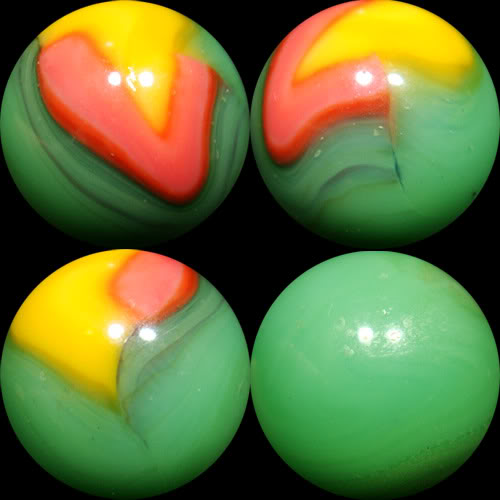 VITRO BLACK EYED PEA
VITRO BLACK EYED PEAThe Vitro Black Eyed Pea is another highly sought after Vitro. The pattern and colors are almost identical to the Sweet Pea accept the Black Eyed Peas have a black patch VS the Pink patch on the Sweat Pea.
These to can range in size..
Vitro Black Eyed Pea
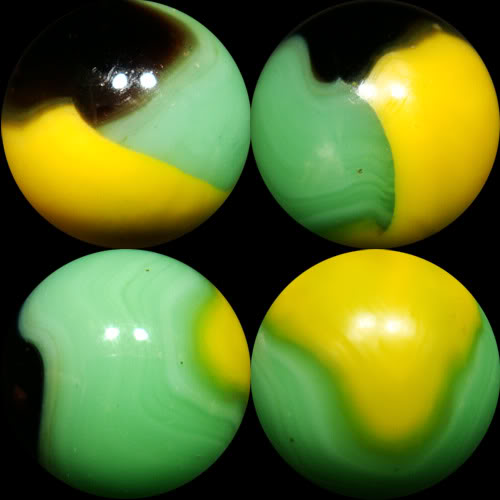
Vitro Black Eyed Pea
